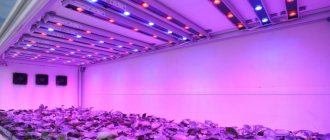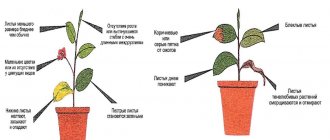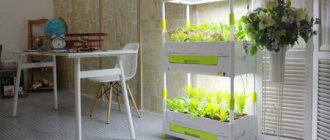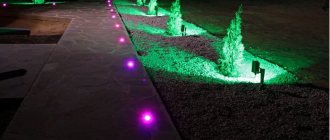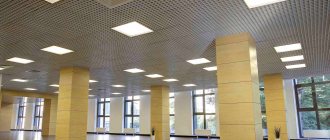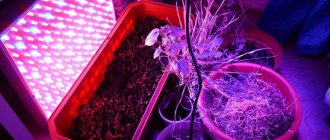For normal growth and development, plants need light, which may not be enough in winter. Lighting a greenhouse with your own hands is not an easy task, but it is a very real task if you know exactly what types of lamps are best used in summer and winter closed ground structures. To properly arrange the lighting, you need to make a drawing or use ready-made calculations to connect all the necessary devices.
Details of arranging lighting for greenhouses with your own hands with detailed calculations, photos and videos can be found in this article.
- Luminescent
- List of required materials and tools
Lighting ranges
Daytime sunlight contains all the colors visible to the human eye and is itself white. This lighting is ideal for plant development.
Some spectrum ranges have a positive effect on plant growth
Artificial lighting affects plants in different ways:
- light in the range from 280 to 320 nm is harmful to vegetation;
- 320-400 nm - light has a regulatory function, very little is required;
- 400-500 nm - blue light, it is necessary during the vegetative growth of the plant;
- 500-600 nm - green, most useful for photosynthesis of lower dense leaves;
- 600-700 nm - red lighting is extremely important for photosynthesis, especially during the flowering period;
- 700-750 nm - “far” red light, plays a regulatory role, is needed in small quantities;
- in the spectral range of 1200-1600 nm, the process of biochemical thermal reactions is accelerated.
Artificial lighting systems for greenhouses
At different periods of their development, plants respond well to different ranges of the light spectrum. Seedlings prefer “blue” light; during fruiting, “red” plays a more important role. But this does not mean that light emission of other colors becomes unnecessary. The lack of full spectrum in artificial lighting causes incomplete taste of the harvested crop. Until lamps that completely imitate solar white light have been invented, lamps with different spectrums of light emission have to be combined in the same greenhouse.
Dependence of photosynthesis efficiency on light wavelength
Prices for phytolamps for plants
phytolamps
Lighting for winter greenhouses: which one is better to choose
The main difficulty in growing plants in winter is the lack of sunlight. To make up for it, be sure to connect sources of artificial lighting.
LED lamps are considered the best for this purpose. They are inexpensive, consume little energy, operate at any voltage, and their light contains all the colors of the spectrum necessary for normal growth and fruiting of crops.
From the video you will learn even more information about how to make lighting in a greenhouse.
Amount of light
Each plant requires a certain amount of light to grow and develop. But there is also a universal rule - plants that bear fruit require more sun than those that produce edible leaves.
Signs of lack of light
Signs of excess light
The requirements for photoperiodicity also differ. Typically, tropical plants need short daylight hours, while northern plants need long ones.
PAR for different plants and vegetables
If you look at popular crops, short-day crops include:
- eggplant;
- zucchini;
- pepper;
- tomatoes;
- beans.
It is enough for them to be in the light for 8-10 hours.
Plants need light as a source of energy for photosynthesis and accumulation of organic matter.
The following crops will require long daylight hours (more than 12 hours):
- garlic;
- cucumbers;
- onion;
- cabbage;
- roots.
The behavior of some plants depending on the length of daylight hours
Note! If daylight hours have become less than eight hours, additional lighting of the greenhouse becomes mandatory.
Basic requirements for lamps for greenhouses
According to the technological design standards for reproductive greenhouses and breeding complexes, the lack of natural sunlight for plants must be compensated for by artificial lighting. It is used when the amount of light entering the greenhouse is less than 90% of the required amount for a particular crop.
All lighting fixtures that are planned to be used in greenhouses, conservatories or greenhouses must meet several basic conditions:
- Waterproof;
- Dustproof;
- Safety for human health.
The high level of humidity and dust that is present in greenhouse structures will quickly destroy conventional lamps.
Lamps that are used for basic lighting must simultaneously provide comfort for people to work in the greenhouse and create a normal level of lighting for plants. Typically these are light sources with a spectrum close to natural sunlight.
Lighting fixtures in the greenhouse must provide normal operating conditions.
Additional lighting should be adjustable. The ability to change the spectral composition of light depending on the phase of plant growth is a very important requirement for light sources for greenhouses and greenhouses.
Industrial lighting devices are widely used in large agricultural greenhouse complexes.
They are subject to increased requirements:
- Ensuring sufficient levels of illumination throughout the greenhouse.
- Long service life of lamps.
- Lighting must be of very high quality.
- High energy costs require high efficiency lighting fixtures.
- They must have increased resistance to the unfavorable climate of greenhouses and mechanical damage.
Organization of lighting in such complexes requires a professional approach.
Types of LED phytolights
Currently, the choice of LED lamps is very diverse. For various plant growing conditions, you can choose ready-made lighting devices, or make the necessary lighting yourself. In addition, LED lighting systems for greenhouses can be used for constant lighting or turned on periodically.
Combined LEDs for greenhouse lighting
LED lamps can be divided according to the main parameters:
- Powers – from 18 W to 240 W. As the power increases, the heating of the lamps also increases.
- Luminous flux – from 1850 lm to 24000 lm.
- Body dimensions - these can be small single lamps or large-sized LED lighting systems.
LED lighting in a greenhouse is usually arranged using high-power full-spectrum LEDs, or by combining lamps of different colors in one lamp. Full-spectrum LED lamps in their design have red and blue lamps, the number of which is selected in accordance with the required ratio for a certain phase of the plant’s life.
Combined LED luminaires
Based on the type of cooling of LEDs in luminaires, a distinction is made between devices with natural and artificial cooling. Artificial cooling is carried out using fans or radiators built into the lighting device. The power of such lamps can reach 1000 W.
Additional parameters by which LED devices can be classified:
- Tightness - depending on the level of humidity and the amount of dust in the greenhouse, the degree of protection of the housing of the lighting device is selected.
- Mounting type - lamps in greenhouses and conservatories can be installed horizontally or vertically, at a high height or directly located above the plants.
- Type of diffuser - currently the basis for dispersing the light flux in LED lighting structures is optical polycarbonate.
- Light temperature – LED lamps can produce light from 2500 K to 6000 K.
To fix lighting fixtures in greenhouses and greenhouses, the following are used:
- Staples;
- Eye bolts for suspension;
- Mounting strips;
- Consoles.
Various types of mounting LED lighting fixtures
LED lighting systems can also be mounted on flexible cables. This allows you to adjust their height and tilt.
Depending on the number of lamps, they can be divided into:
- Single - used to illuminate a small planting area.
- Strip - a regular LED strip is very easy to use.
- Floodlights – used to illuminate large areas and are characterized by increased protection from moisture.
The most commonly used light sources are a combination of blue and red diodes.
Light in the greenhouse
Natural light is ideal. In order to provide them with the maximum amount of plants, the greenhouse should initially be installed taking into account the location to the cardinal points. The greatest amount of light enters the greenhouse in the north-south direction. The design of the greenhouse itself plays a significant role.
Correct location of the greenhouse on the site
Illumination of greenhouses of various designs
If one of the walls of the greenhouse is in contact with the building, it (the wall) is made reflective using mirrors or foil or painted with glossy white paint.
Calculation of the power of phytolamps for a greenhouse
Different stages of plant development in a greenhouse require different action spectra. Moreover, the number and power of phytolamps for greenhouses are interconnected. However, to calculate these parameters, you need to know the lighting area, the type of crops, the material from which the greenhouse is built, the type and power of light of each phytodevice. Below is a diagram and table for calculating the power and number of lamps for a greenhouse.
In addition to lighting, it is necessary to maintain an optimal temperature for comfortable plant development.
Artificial lighting
Thanks to technological progress, modern gardeners provide greenhouse plants with light both at night and in winter, while artificial lighting:
- improves plant growth (growing exclusively with natural light significantly reduces productivity);
- allows you to receive products in a shorter time and at a time when demand for it is highest;
- helps to grow heat-loving crops that are not found in the local climate;
- reduces the final cost of vegetables by 15% by increasing yield.
Artificial greenhouse lighting
Types of light modes for a greenhouse
- The light flux comes in the quantity strictly required for the plant. The light energy density ranges from 400-1000 mmol/m2. Lighting can be made continuous by using special relays that automatically turn on the lamps when the intensity of sunlight decreases.
- Night lighting is required when daylight hours are artificially extended. Energy density decreases to 5-10 mmol/m2. The lamps are turned on only from time to time. With this approach, you can either slow down or speed up the flowering time. Acceleration of growth is achieved by frequently turning on a weak color every half hour. During the time the lights are turned off, the plants do not have time to “fall asleep” and grow in the same way as with constant light. Incandescent lamps with a reflector can handle this task.
Incandescent reflector mirror lamp
If none of the regimes are followed, you cannot expect quality products. Vegetables will bloom without bearing fruit, and vegetative plants will not even reach flowering.
Lighting in the greenhouse business: what investors and managers need to know
Government support is not the only factor of investor interest. This niche is still relatively free and promising - by 2025 it is planned to develop 3,284 hectares of industrial greenhouses, with the current volume of about 3,000 hectares. At the same time, the existing business is moving to an intensive stage of development and is looking for tools to reduce energy costs, which significantly affect the cost of production.
In this business, one of the most important roles is played by assimilation - or artificial - lighting. Costs, product quality and, as a consequence, profits depend on it. Wim Steeghs, sales director for horticultural lighting at Signify in Central and Eastern Europe, talks about how to create the right light in a greenhouse to save energy and grow more crops per square meter
Ecology of photosynthesis: why proper light is so important for plants
The most common solutions for greenhouses are sodium gas-discharge lamps (HPS) and LED lamps. Both types have a beneficial effect on plants and make it possible to grow fruits all year round in almost any region of Russia.
The spectral composition of lighting, as well as the type of lamps used, is reflected in the qualitative and quantitative indicators of yield. Therefore, one of the main topics of discussion among plant growers is the correct light, thanks to which photosynthesis occurs. During this process, the plant absorbs carbon dioxide under the influence of light, synthesizing sugars formed in starch. These organic substances are necessary for the growth and development of fruits. A scientific mystery for agronomists is how to use lighting to force plants to distribute them in favor of the yield rather than the green mass.
Science has already gone quite far in this direction. In the process of many years of research and testing, it was found that the red spectrum stimulates tissue growth, and the blue spectrum stimulates differentiation processes during development (tassel formation, shoot formation, flowering, root formation). This knowledge allows you to select the correct spectrum and amount of light in accordance with the characteristics of a certain type of vegetable. For the same reason, agronomists are switching attention from classic sodium solutions to modern lighting that can be finely tuned. The light is selected individually to use the plant's resources to their full potential and produce more and better quality crops.
Why is assimilation light necessary even in summer?
Year-round cultivation of plants in a greenhouse involves the use of assimilation lighting throughout the year, both in winter and summer. Why? Firstly, in winter, sunlight does not come in sufficient quantity to grow plants in a greenhouse - this is true even in the southern regions of Russia or such hot countries as Turkey, Azerbaijan, etc. Secondly, excess solar radiation - or insolation - overheats the air inside the greenhouse, and this directly affects the plants. High temperatures stimulate the growth of green mass instead of ripening the crop - this affects the taste and quality of the product. For this reason, the amount of sunlight in the greenhouse is reduced using special shading systems. In addition, even with moderate insolation, a third of natural light does not reach greenhouse seedlings - it is lost in reflections, “bumps” into pipelines or other structures. Also, sunlight has a greater variety of wavelengths than plants need - they only consume light in the PAR (photosynthetically active radiation) range. For this reason, the amount of sunlight cannot be equated with the amount of artificial light.
If we talk about the winter period, then, according to NASA, per one square meter of soil even in Krasnodar, one of the sunniest regions of Russia, in January-February only 350 J/cm2 per day is received; 5 moles/m2 per day gets inside the greenhouse . At the same time, vegetables on average require more light for high-quality growth. For example, a tomato needs a minimum of 15-20 mol/m2 per day, and the recommended value is 27.5 mol/m2 per day - then photosynthesis will be more efficient and yields will increase. If there is insufficient lighting, “winter” crops will grow, but it will take a long time, and the fruits will be tasteless, like a water balloon. During the fall and spring, plants also do not have enough natural light to produce enough crops.
Calculation of the total amount of lighting: sunlight plus assimilation
Lighting accounts for up to 90% of the enterprise’s total energy consumption, so to reduce costs it is necessary to accurately calculate the power of the lamps, which depends on the location and type of vegetables.
1) First, the level of natural insolation in the location where the greenhouse is located is determined. This information can be found in the NASA database or calculated independently based on the latitude and longitude of the greenhouse location. 2) The next step is to study the characteristics of the crop and variety. Each crop is characterized by different needs in the amount of light (moles), spectrum composition, period and intensity of additional illumination. Thus, tomatoes need 27.5 moles/m2/day, while roses need more than 30 moles/m2/day. Often the decision of how much light to give a plant and when is also determined by economic factors - depending on the price per kg of fruit and the cost of energy. 3) The greenhouse light transmittance coefficient of 0.7 is applied to the indicator reflecting the required amount of light. This determines the deficiency that the plant will experience. This difference is compensated by installing lamps of the required power.
The gray and orange bars represent the hours/day that overhead lighting (in gray) and row lighting (in orange) are operating that week. The orange line is the amount of natural light (in moles/m2/day). The blue line reflects the total amount of light, natural and artificial (in moles/m2/day). So the blue line is the light inside the greenhouse. It should be as permanent as possible
Sodium discharge lamps vs. LED - what to choose?
Currently, both sodium gas-discharge lamps (HSD) and LED solutions are actively used on the market. At the planning stage, the investor is faced with the question of which system will be used in the project - each type has its own characteristics. LED and sodium lamps can be combined - such a system is often called combined (or hybrid). Hybrid systems can be used both for overhead lighting and in a combination of overhead and inter-row placement.
The main advantage of gas-discharge lamps is their purchase cost. They are cheaper than LEDs due to the fact that the latter uses semiconductor materials to achieve high energy efficiency. In addition, LED lamps allow you to customize the spectrum and create conditions as close as possible to the ideal spectrum, whereas sodium lamps do not have a spectrum that can be adjusted. The prices of such solutions differ from different manufacturers, so they can be compared in terms of the cost of energy spent on the production of one mole of light:
● When using a gas-discharge lamp with a power of 1000 W and an efficiency of 1.8 μmol/J, one mole of light costs 0.62 rubles, with an energy price of 4.0 RUB/kWh ● When using a LED lamp with a power of 600 W and an efficiency of 3.5 μmol /J one mole of light costs 0.31 rubles. at the same 4.0 rub./kWh.
The above calculation shows that when using LED backlighting, significant savings in energy costs are achieved. At the same time, LED modules allow you to customize the spectrum for more intensive plant development and can be used for inter-row lighting, as well as for a longer time compared to sodium ones. The use of inter-row lighting can be 50% more effective than just overhead lighting with the same amount of light in moles.
Gas discharge sources emit heat in addition to light. This can be both an advantage and a disadvantage. At a light intensity of 200 µmol/m²/s, greenhouses often overheat. However, in winter this heat is not enough and heating systems have to be used. Thus, a good choice of hybrid lighting is a situation where the main top or inter-row lighting is LED, and additional lighting is sodium, which can be turned on if necessary to raise the temperature in the greenhouse.
For example, the group and GGT are using a combination of inter-row LED modules and "solo" sodium lamps to compare yields across different systems. Based on the results of the last two years, in Agrokultura, the combination of inter-row LED lamps and HPS when growing Confetto tomato increased the yield by 18% in annual terms, and by almost a quarter (+24%) during the period of highest demand - from November to early March. At the same time, energy savings were achieved: the same amount of light generated by sodium lamps consumes 40% more electricity. Inter-row LED lighting was also 50% more efficient than overhead sodium lighting.
An equally important role is played by the distribution of light flux. Classic solutions involve only placing the lamp on top, in which no more than 10% of the light falls on the level of the lower brush. As noted above, “Agriculture” uses inter-row LED lighting, which allows you to redistribute part of the radiation in the vertical plane. When dividing the conditional 100 micromoles into two sources - top and inter-row, the yield increases at the same level of energy consumption.
The Agro-Invest greenhouse complex uses fully LED lighting (top and inter-row LED modules) on 68 of its 105 hectares. Due to this, energy consumption is reduced by almost 40%. This also leads to cheaper infrastructure - costs for transformers and gas generation are reduced proportionally.
LED lighting is more relevant than ever for vertical farms - enclosed spaces without natural light. This format will become very common in the future. It allows complexes to be located in cities so that vegetables reach the shelves fresher and tastier. There is no need to rely on sunlight here, so only LED lamps are used, which do not disturb the temperature in the room and create lighting conditions close to natural on a fine summer day.
The Russian manufacturer RIAT was the first in the world to establish the cultivation of tomatoes and cucumbers in an enclosed space without access to natural light. Every week the company collects from 2.7 kg to 3.2 kg of cucumbers per m2, tomatoes - 1.7 kg/m2. Marketability of products - an indicator reflecting the ratio of the number of quality fruits to their total quantity - is 99%. from the second year of work.
Lighting trends for the greenhouse business
Technology is penetrating deeper into the crop production industry. Vertical farms are being actively built in Europe, and individual light recipes are selected even in small greenhouses with an area of no more than two hectares.
The future lies in optimizing costs for technological solutions. The circular economy may soon be reflected in greenhouse growing, which will reduce the cost of maintenance and increase investor benefits. Already now, other lighting industries are practicing “circularity” technology, when a business can pay only for light, and not for equipment. At the end of their service life, the company returns the lamps to the manufacturer for reuse or recycling. So far, manufacturers are not implementing such projects for greenhouses in Russia, but experts are working on this to increase the investment attractiveness of advanced technologies.
In addition, technologies for greenhouses are spreading to other branches of crop production - for example, floriculture. Now flower growers in Russia work in rather harsh conditions, selling no more than 220 million cut flowers per year. This amount does not exceed 15% of the market - a total of 1.47 billion cut flowers are sold in Russia, the rest comes from imported products. This may be another competitive factor that has a particularly strong impact on manufacturers in the absence of government support measures. Therefore, innovations can become relevant for manufacturers in Russia, because they can optimize costs and improve product quality in order to have a competitive advantage.
Greenhouse electrification
Step 1. First you need to draw a detailed plan indicating the locations of light sources, switches and wire routes.
How to properly place plant lighting
This greenhouse lighting diagram shows power outlets at both ends, four HID lights above the growing areas, fluorescent lights above the aisle for general lighting, and outlets for heat mats and power tools
Step 2. The required footage of wires, the number of junction boxes, lamps, switches and auxiliary materials are calculated.
Table of recommended lighting power relative to greenhouse area
Advice! Wires should be preferred with a cross-section of at least 2x2 cm. To facilitate future wiring repairs, you can use wires of different colors. One color will indicate phase, the other will indicate zero.
Step 3. Everything you need is purchased (with a small reserve). All elements must be moisture resistant.
Step 4. The wire is removed from the distribution panel located in the building. An automatic greenhouse switch is installed in the common meter of a residential building.
Distribution panel
Step 5. Electrical wiring to the greenhouse is carried out.
Example of electrical circuit diagram in a greenhouse
Method A - underground:
- a trench is dug at least 80 cm deep; it should not intersect with the drainage;
- the wire with a protective screen must be covered with tiles in order to protect it in the future when digging up the earth.
Underground cable laying diagram
Laying electrical cable in a trench
Method B - by air:
- pillars are installed;
- at a safe height, the cable is tied to the wire connecting the two poles.
Cable supply by air
Electrical wiring must be located away from trees, which can break the cable with branches in a strong wind.
The nuances of laying electrical wiring in a greenhouse
Step 6. The cable is connected to the shield inside the greenhouse.
Step 7. Wires in a special corrugation are routed to sockets and switches. All fasteners and terminal blocks are insulated.
Connecting a corrugated wire to an outlet
Connecting wires with a screw terminal block
VAGO clamp for connecting wires
PPE cap for connecting single-core wires
RADIATION MEASUREMENTS IN CVT
We have already written earlier [2] that in greenhouses where only low-pressure heaters are used, light parameters (luminous flux and luminous efficiency) fully characterize the efficiency of the light source. However, it is becoming “fashionable” and inappropriate to operate with such a concept as “micromole”. In articles in magazines, presentations, advertising brochures you can find numbers such as “20-gZO, 105,220, etc. µmol". One can only guess what the authors mean. The word “µmol” itself simply means the number of particles in space; it is unlikely to characterize any specific technological process.
The use of the concept “μmol” means the introduction of a new metrological photonic photosynthetic system (PPS) value into circulation. Let us note that in our country the FFS is not standardized and metrologically ensured, and the instruments used for measurements are not included in the measurement register. However, in connection with the beginning use in pilot projects in CVT of “potential carriers” of FFS - red-blue LED emitters, the measurement of radiation of which is impossible using light quantities, this problem will have to be dealt with. Returning to the example given above, we note that the authors probably mean photon photosynthetic irradiance, the value of which can be written as “μmol/(m2*s)>>.
In the FFS system, it is possible to measure radiation and NLVD and compare it with the radiation of red-blue LED emitters. In table In Table 2 we have given the emission parameters of the NLVD in both systems: light and FFS.
Spectrum is different
To create effective artificial lighting inside a polycarbonate country greenhouse, halogen or fluorescent lamps are best suited. They are good because they do not heat up and, accordingly, do not provoke unnecessary changes in temperature and air humidity. This makes it possible for the summer resident not to use expensive automatic devices to maintain the optimal temperature inside the greenhouse. Experts recommend buying special lamps for greenhouses, since they are initially equipped with lamps whose emission spectrum is ideal for the proper development of plants. Infrared and red components of the light spectrum have a beneficial effect on the growth of greenery, while blue components have a depressing effect.
Economy option - incandescent lamp
Incandescent lamps are a glass bulb with a metal filament - a filament body. Under the influence of an electric current, tungsten heats up and emits light. In addition to the usual household light bulbs that are well known to everyone, more modern varieties have appeared that are used in greenhouses.
Ilyich's light bulb is not the best option
There is such a light bulb in every home. Glass flask with a characteristic pear-shaped shape. Inside there is a tungsten filament twisted into a spiral. She is in a vacuum. The light bulb is connected to a 220 volt network through an ordinary socket. No transformers or converters are needed. This fact and the fact that an incandescent light bulb costs very little are the main advantages of this choice for small greenhouses.
This lamp has many disadvantages. First of all, the range of frequencies that hot tungsten emits is too small. There is a lack of blue light, which has a bad effect on the growth and development of plants. In addition, such a lamp gets very hot. Excess heat does not always have a good effect on the condition of the seedlings.
The low price of the light bulb is fully compensated by the high energy costs. According to some sources, the efficiency of an incandescent lamp does not exceed 10%. In addition, the lamps burn out quickly. Using such lamps is uneconomical in the long term.
This type of lamp is the easiest to use.
Halogen lamps for greenhouses
A variation of this series is the halogen lamp. It differs in that the glass bulb with the filament body is filled inside with halogen gas. The most commonly used are iodine, bromine, krypton and xenon. The use of a gaseous medium is due to the fact that, when heated, tungsten atoms are separated from the filament. They react with halogens. Under the influence of high temperature, the compounds break down into their components. Thus, the tungsten atoms return to the helix.
This method solved several problems of incandescent lamps at once. The spiral lasts longer, which means the light bulb does not burn out. The intensity and brightness of lighting increases, which is very important for a greenhouse. Halogen lamps also connect to a regular socket, but they look much more compact and neat.
Daylight indoors
Neodymium lamps - a source of phytolight
This variety differs in the material of the flask. Manufacturers added neodymium oxide to the glass composition.
This glass has an unusual property. It absorbs the yellow part of the spectrum and makes the light from the light bulb closer to daylight.
The effect of this lamp is visible to the naked eye. In fact, increasing the brightness of lighting with a neodymium light bulb is a purely visual effect. The tungsten filament does not emit more light because the glass of the bulb has changed. The emission spectrum, as in a conventional incandescent lamp, is devoid of blue components and UV rays. Infrared radiation predominates. The light output of all incandescent lamps is low.
